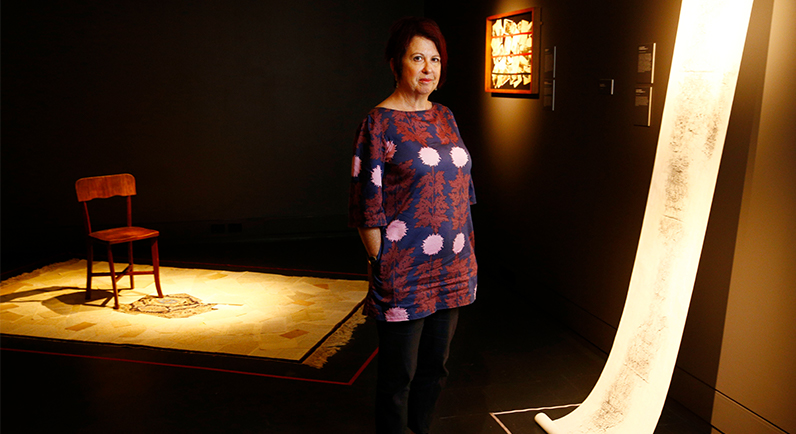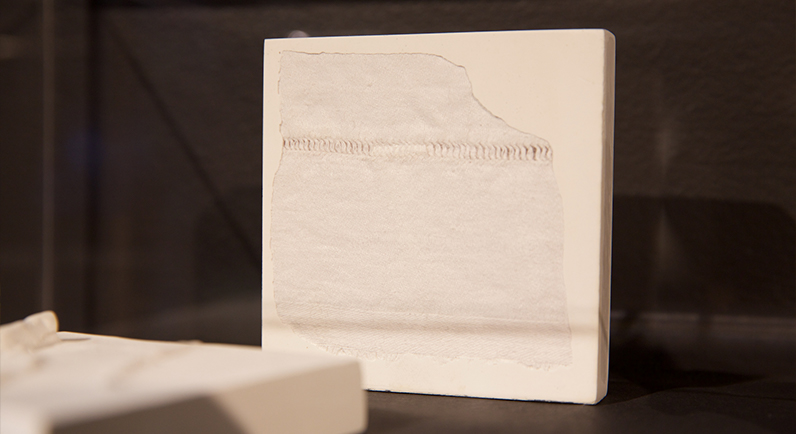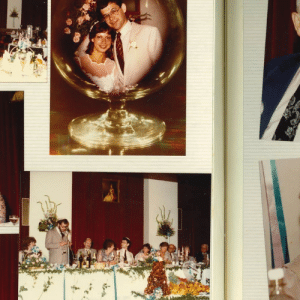Blog
January 3, 2019
Interview with Sylvia Griffin
Australian artist Sylvia Griffin has put her personal history and family’s traumas on display alongside Anne Zahalka’s in our current contemporary art exhibition, The Fate of Things: Memory Objects and Art.
We sat down with Sylvia to understand more about her relationship with memory and trauma, and how she connects with them through various materials.

Photograph by John Appleyard.
SJM: When was the first time that you remember learning of your parents’ experiences of the Holocaust?
Sylvia: I feel that I’ve known about the Holocaust for as long as I can remember. I have memories of seeing disturbing imagery of the Holocaust from fairly early childhood and as I grew older I was quite a vulnerable and fearful child. My parents’ experiences were never entirely clear. They would each talk about different aspects of life in Hungary ‘before’ the war, but not so much about the ‘during’. As I grew older, it was my aunt who told me a few more details about life in Hungary during those war years, especially about things that happened to my mother, as my mother was reticent to speak about such things.
SJM: What kinds of emotions does working through traumatic histories through your art making process bring up?
Sylvia: Working with my mother’s textiles is a particularly special experience that connects me to her and to the women in my family. I don’t know if textile craft (sewing, knitting, dressmaking etc.) is particularly strong in Hungarian culture, but it was in my family.
Most of my work is process-driven and it’s particularly important to me to use my hands and often my whole body in the making of artwork. Some works have surprised me with the emotion they have elicited from me; for example, in the process of being filmed unravelling the cardigan in the video “Unknitting/Rewind”, I had expected to be moved to tears – I even had a tissue in my pocket in anticipation – only to find that I actually became quite irritated as the end of each knitted row was knotted, making the task lengthy and frustrating. I had to admit to myself that this reaction was possibly a more realistic one that reflected the loving but at times difficult relationship I had had with my mother.

Sylvia Griffin, Little Memorials, 2018. Photograph by Giselle Haber.
SJM: Tell us a bit about the materials and media that you work with and how these materials connect to your history and memories.
Sylvia: I tend to use whatever materials I feel will best suit what it is I’m trying to express. While the works in the show feature a lot of textile-based pieces as well as plaster, video, wax and paper, my practice also features bronze and marble. I often focus on the potential of materiality to challenge our expectations of works of mourning or commemoration and do this by playing with notions of hard and soft, personal and public. In some work I have used traditional memorial materials such as bronze and stone to make intimate works, enabling viewing at eye-level, or at a size that could be held in one’s hand. In this way I aim to invoke an experience of intimacy and contemplation rather than the static, impersonal memorial experience we often encounter.
Other pieces use plaster – traditionally considered a rather lowly or provisional material that is usually the first stage in making work in a grander material, such as marble. I like that plaster can mimic more familiar memorial forms. “A Weighty Thing” demonstrates this, where the square plaster form sits heavily on the ground on its low plinth and is covered in graphite to resemble metal.
The textile works – my mother’s dowry linen, my aunt’s sewing notions, my grandmother’s linen and my mother’s knitting, all connect me to these people and our shared family history and keeps their memory alive. While many of the works in the show can be considered works of mourning, some also hark back to my childhood and feelings of comfort, feeling that I believe others can also relate to.
SJM: Are there any other influences and inspirations that inform your works in The Fate of Things: Memory Objects and Art?
Sylvia: There are several artists who have inspired and influenced me. The work of several post-Holocaust German artists such as Jochen Gerz, Horst Hoheisel, Gunter Demnig, Christian Boltanski and others such as Shimon Attie, Esther Shalev-Gerz, Anish Kapoor and Rachel Whiteread have all found ways of expressing loss, grief and absence in very considered, thought-provoking ways through contemporary art. Many of these artists challenge the traditional aspects of commemorative works, often in response to the Holocaust.
There is also a group of South American artists who, whilst responding to on-going traumatic events in their countries and the phenomenon of the ‘disappeared’, are similarly concerned with activating memory and expressing grief through commemorative actions and artwork. These artists – Doris Salcedo, Alfredo Jaar, Lika Mutal and Oscar Mūnoz have particularly affected the way I work materially.
The Fate of Things: Memory Objects and Art is in display at the Sydney Jewish Museum until 28 February. For more information about the exhibition, click here.






What’s On Newsletter
Keep up to date on all Museum events and exhibitions.